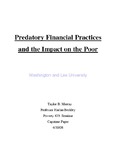Predatory Financial Practices and the Impact on the Poor

View/
Author
Murray, Taylor B.
Subject
Washington and Lee University, Shepherd Poverty Program
Poverty
Financial literacy
Finance, Personal
Predatory lending
Subprime mortgage loans
Metadata
Show full item recordDescription
Taylor B. Murray is a member of the Class of 2009 of Washington and Lee University. Capstone; [FULL-TEXT FREELY AVAILABLE ONLINE] In summary, the solutions for breaking the cycle of poverty presented by this paper focus heavily on reducing the exorbitant costs of financial services paid by low-income families. This is in contrast to the long-standing public policy emphasis on putting more money into the hands of the poor by means such as increased government aid, raising the minimum wage, and expanding tax credits. This new approach is driven by the astounding increase in credit made available to the low income population in the past decade. It recognizes that without establishing principals of fairness in lending to the poor, accompanied by increasing their financial literacy and attracting legitimate banks into their communities, the newly available debt may push some low income households over the financial edge. [From Solutions] Taylor B. Murray